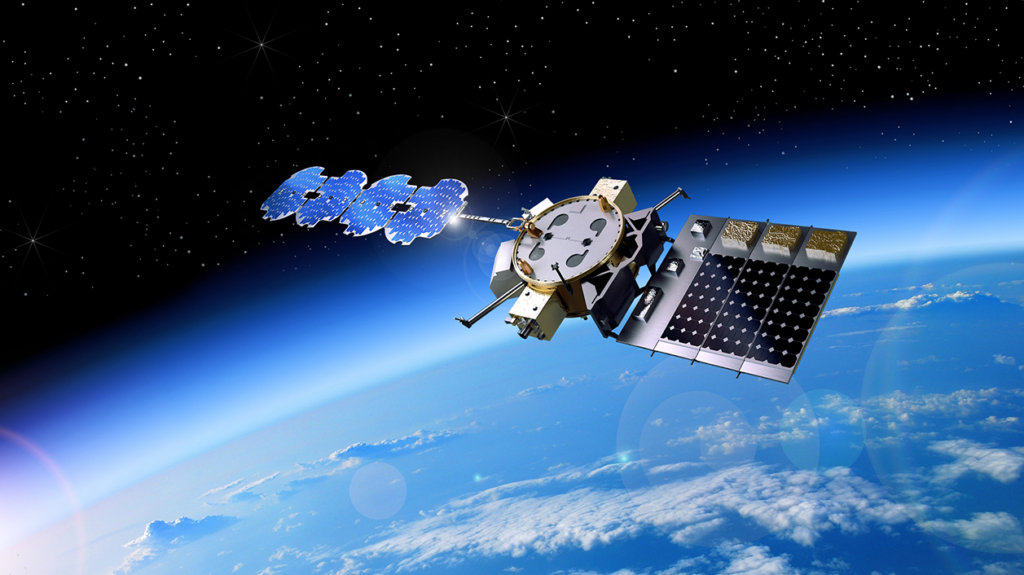
Artist’s image of AFRL’s Arachne experimental solar power satellite (AFRL)
WASHINGTON: A satellite constellation harvesting the sun’s energy and beaming electricity to forward military bases or even interplanetary spacecraft is an idea that for the moment remains in the realm of science fiction. But the Air Force Research Laboratory’s Arachne effort has taken a big step toward making it a reality with a successful ground test of a lightweight tile for collecting solar radiation, project officials said today.
The test successfully completed Arachne’s first critical milestone, Program Manager James Winter told Breaking Defense.
“We’re just thrilled about that, because that allows us to continue on our path that we have laid out for the portfolio in really our keystone demo,” he said with audible excitement.
Arachne is the flagship mission for AFRL’s ambitious Space Solar Power Incremental Demonstrations and Research (SSPIDR) initiative, a portfolio of interrelated projects to demonstrate foundational technology for solar power satellites.
The mission ultimately will involve launch of an experimental satellite, based on the Helios bus provided by Northrop Grumman Space Systems. The Arachne sat will carry the Space Solar Power Radio Frequency Integrated Transmission Experiment (SSPRITE) payload, also being developed by Northrop Grumman, to collect and convert solar energy.
AFRL awarded Northrop Grumman slightly more than $100 million in 2018 for Arachne. Furthermore, the company has invested some $15 million of its own research and development money into the project, according to Jay Patel, the firm’s remote sensing programs business unit vice president.
There are a number of technologies already used by other Northrop Grumman programs that have applicability to Arachne, he said, such as phased arrays and “all of the different beamforming technologies and things that are required to move that energy around as needed.”
“A lot of these technologies, if you break them out separately, they’re not revolutionary. But putting them together in this application is,” Patel said.
The just-completed SSPRITE ground test proved that a so-called “sandwich tile” could convert solar radiation to radio frequency (RF) waves at a large enough scale to be useful for building a space-based solar power collection system.
Arachne project managers James Winter, AFRL, and Tara Theret, Northrop Grumman, model the photovoltaic and the radio-frequency sides of the “sandwich tile” used to convert solar radiation into RF energy. (Northrop Grumman)
“The sandwich tile consists of two layers. The first layer is a panel of highly efficient photovoltaic (PV) cells which collect solar energy and provide power to the second layer. The second layer is populated with components that enable solar to RF conversion and beamforming,” explained AFRL’s press release.
The next step, Winter said, is to build nine tiles in total and then integrate them into a “panel” that will be the heart of the SSPRITE payload to be demo’d on orbit. Other aspects of the demonstration will involve testing the ability to accurately beam the converted RF energy to a dish antenna for collection. (Large-scale collection and distribution of converted solar energy — whether in the microwave or optical range — is yet another hurdle to be overcome before space-based solar power is feasible for use on Earth.)
The ground test of the tile was made possible by yet another new type of technology: a solar radiation simulator “to illuminate the PV side of the tile and begin the Solar-to-RF conversion process,” the press release elaborated. “Because the solar simulator was so intense, attendees viewed real-time RF output data on monitors from behind an industrial grade flexible plastic barrier, and cheered when an RF energy peak appeared indicating successful power conversion and RF radiated power.”
Winter explained that on Earth, the atmosphere filters solar radiation so that it is conducive to human and other terrestrial life. But in the vacuum of space, as NASA well knows, unfiltered solar radiation is much, much stronger and thus harmful.
Indeed, solar radiation also is a problem for the sensitive electronics aboard satellites. And given that solar-power collection components would need to be directly exposed, another part of AFRL’s overarching SSPIDR initiative is aimed at developing ways to safely handle the heat. That experiment, called SPIRRAL, for the Space Power Infrared Regulation and Analysis of Lifetime, will demonstrate “thermal management” technology and is set to fly on the International Space Station in 2023. SPIRRAL will actually be the first on-orbit demo under SSPIDR.
Winter said that Arachne’s initially envisioned launch date of 2024 now has been pushed back to early 2025 — not because of any internal problems, but because of the difficulty of getting a ride to Low Earth Orbit.
“Ultimately the boosters going to set our timeline,” he said. “But we’re going to be ready for that, and we’re already performing a lot of pre-integration activities … for the prime payload on Arachne.”
Space Force EW unit working to integrate new weapon systems, intel personnel
The Space Force’s Delta 3 is responsible for organizing, training and equipping Guardians for electronic warfare missions involving satellite communications, as well as sustaining related offensive and defensive EW systems.


























